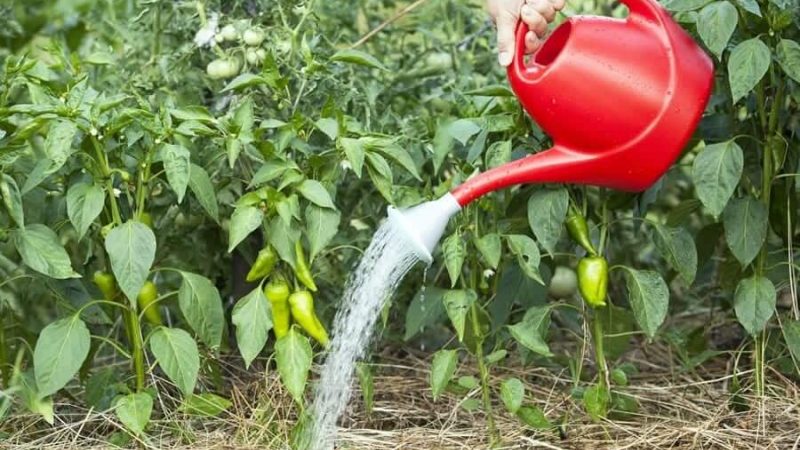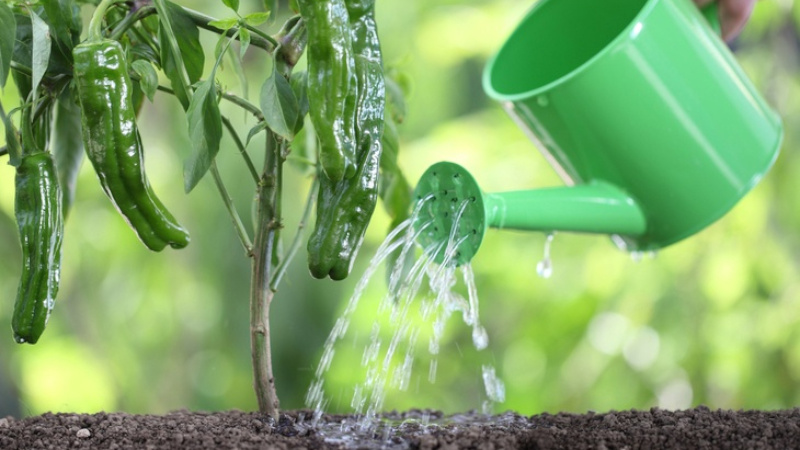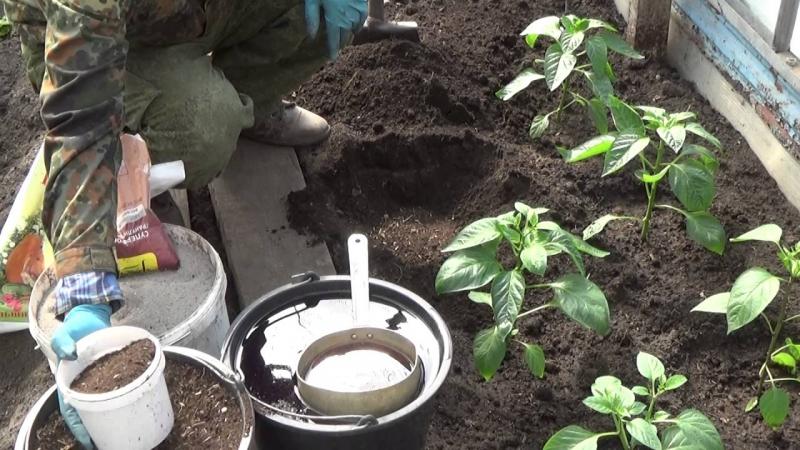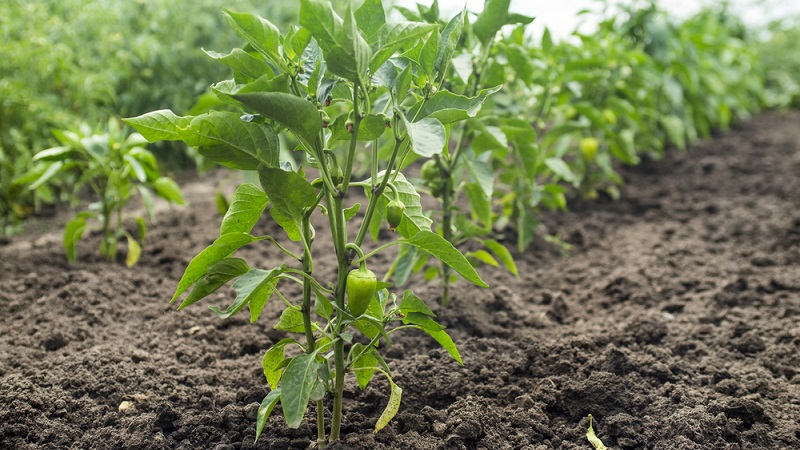How to water pepper in the open field correctly: instructions with advice from experienced gardeners
Pepper can hardly tolerate drought. Its root system grows in the surface layer of the soil, so it is important to ensure that the earth does not dry out. Compliance with simple rules for watering will prevent flowers and ovaries from falling off, and will avoid many other troubles.
The content of the article
How to water peppers outdoors
Pepper is a thermophilic culture. However, many gardeners manage to successfully grow it in the open field even in central Russia. The secret lies in proper plant care, and one of the main aspects is proper watering.

Step-by-step instruction
In order for the culture to develop in accordance with the norms, it should be watered, following the recommendations:
- try to get into the hole in which the bush grows so that moisture does not spread over the surface of the earth, but gets to the roots;
- use settled warm water;
- serve liquid in small portions to avoid soil erosion and exposure of the root system;
- moisten the soil from one edge, and loosen from the other, while alternating the sides.
The loose topsoil protects the roots from drying out. It is better to water the soil less often, but loosen it more often.
Frequency and abundance of watering
Water the peppers at least twice a week. For every 1 m² of garden beds, approximately 11 liters of water are required. In rainy weather, this volume can be reduced.
Attention! If the soil is irrigated only once a week, pour up to 16 liters of liquid over the same area.
Irrigation types

There are several watering options:
- Drip irrigation. A hose equipped with a special filter and droppers is connected to the water supply source. It is one of the best irrigation options for outdoor crops. The soil is moistened evenly, no hard crust forms on its surface. In addition, water evaporates more slowly.
- Manual watering... A common but rather laborious method, mainly used in small areas. Any containers are suitable for watering: watering cans, plastic bottles, buckets. You can spray the peppers with a hose.
- Surface watering. Ideal for dry areas. Grooves are dug between the rows, which are filled with water. This allows the bushes to consume the required amount of moisture.
- Subsoil watering... Underground pipes are laid through which water enters the plants. This method guarantees uniform moisture and no risk of pathogenic bacteria entering the leaves.
- Sprinkling. Irrigation devices that simulate rain are placed on the beds. The necessary equipment is easy to find on the market and easy to use, but in an arid climate it will be difficult to achieve the desired level of soil moisture.
Features of watering bell and hot peppers
Sweet and bitter peppers should be planted as far away from each other as possible, otherwise the crops will become over-pollinated and their taste will be disturbed.
Bell peppers are often watered, but not too abundantly. Otherwise, the plant may be affected by apical rot.
Hot peppers are watered as the soil dries out. It is impossible to allow waterlogging of the soil, the root system may begin to rot. Only warm water is suitable for watering the crop.
Watering nuances depending on the period
As the plant grows, its moisture requirement changes.Monitor the development of the pepper to ensure proper care.
Seedlings
Seedlings are planted in open ground in cloudy weather or in the evening when solar activity decreases... Before planting, the soil is well moistened and wait until the moisture is absorbed.
While the plants have not bloomed, they are watered every 7 days. In the heat, when the soil dries up quickly, it is moistened up to 3 times a week.
Bloom
After the flowers appear, the peppers are watered 2-3 times a week and only at the root. Otherwise, pollen will be washed off them. Flowering takes place in several stages, so the soil is moistened immediately after the opening of new buds.
Watering during fruiting
During the formation of ovaries, the frequency of watering is reduced to 1 time in 4 days, increasing the flow rate per 1 bush to 5 liters.
For the development of large, juicy fruits, the soil is moistened once a week. With insufficient watering, the peppers will grow small and tasteless. 10-15 days before harvesting, the supply of moisture is stopped: this will allow the fruits to ripen faster.

Other factors
Plants are watered after each feeding - this way the nutrients are absorbed much better. Liquid fertilizers are applied every 2 weeks.
reference... In addition to mineral and organic compounds, nettle infusion, rich in potassium, calcium and magnesium, favorably affects the growth rate of the culture.
During the heat, water the pepper at least once every 2 days. The volume of water should be enough to reach the roots. If the thermometer rises to + 22 ° C, not only the plants are moistened, but also the space between them. In this case, each pepper will have a reserve of moisture underground.

Possible errors and their consequences
Waterlogging causes irreparable harm to plants. Too moist soil prevents the root system from breathing. Humidity contributes to the development of putrefactive processes and the rapid multiplication of fungi, the spores of which will not be easy to get rid of in the future.
Excessive watering is especially dangerous in hot sunny weather. The drops of liquid covering the leaf plates multiply the effect of ultraviolet radiation, burning the plant.
If the bell pepper dries up, especially during fruit setting, ripe peppers will be bitter. Light or brown spots appear on the pods and stem of chili in dry weather. With a strong moisture deficit, the leaves of the plant wither and turn yellow, it slowly dies.
Tips & Tricks

For a rich harvest, follow the advice of experienced gardeners:
- If a crust forms on the surface of the soil, loosen the soil to achieve even moisture in the root zone. It is best to make a small funnel around the plant and mulch it.
- If the soil is sticky and dense, take a few days off watering.
- To avoid killing the crop with excess moisture, loosen the soil around the peppers, and then water them. If puddles appear and moisture no longer flows to the roots, stop watering.
- Allow chlorinated tap water to settle within 24 hours. If the water is too hard, add wood ash - half a glass to a bucket of liquid.
- Even in rainy weather, don't forget about irrigation. The exception is long and heavy showers.
- The optimum water temperature for irrigation is from 22 to 25 ° C. You can dilute the well water heated or collect moisture from containers left in the sun.
- If the soil contains a lot of sand, moisture practically does not linger in it, therefore water the culture more often. To improve the quality of the soil, compost or peat is added to it and do not forget to mulch the plants.
Read also:
How to properly water onions in the open field and in the greenhouse.
Conclusion
Peppers are relatively unpretentious, but need proper and regular care. One of the most important conditions for normal development is proper irrigation.Based on weather conditions, plant stage and other factors, experienced gardeners adjust the amount and frequency of watering to get a good harvest of tasty peppers.